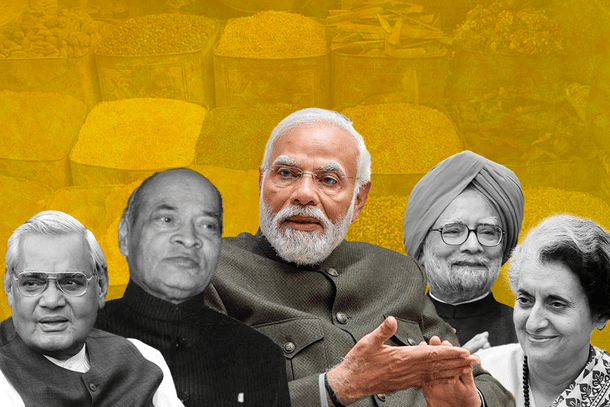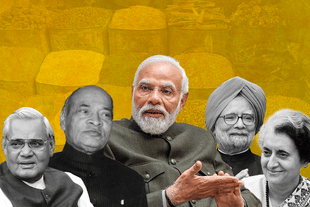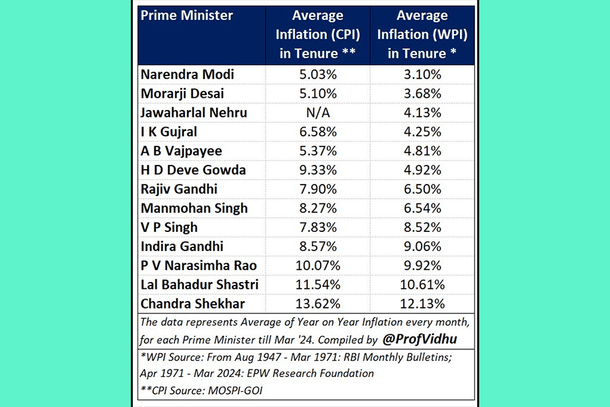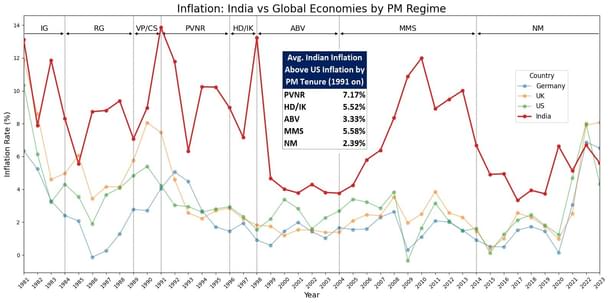Economy
Data Reveals PM Modi Has Best Record On Inflation Among All Prime Ministers
Prof. Vidhu Shekhar
Apr 22, 2024, 01:33 PM | Updated Apr 23, 2024, 12:33 PM IST
Save & read from anywhere!
Bookmark stories for easy access on any device or the Swarajya app.


Among India's smarter political analysts, Prashant Kishore attributes PM Modi's popularity and electoral wins to four key factors: BJP's commitment to Hindutva, a new form of nationalism, BJP's financial and organisational strength, and the Labharthis, those who have benefitted directly from his welfare schemes.
Having entered the Indian political landscape relatively recently, we can perhaps forgive Kishore for missing another very important factor that has traditionally been critical in deciding the fate of the incumbent government in India — inflation or mehngai.
Any politician will tell you that inflation can make or break the government. Inflation effectively acts as a tax on everyone, impacting every citizen daily, regardless of their wealth. It particularly affects the poor and middle-income people, directly impacting their budget and expenses. In poor, it can lead to literally having less food.
Inflation could arguably be the most significant political-economic variable in any country, especially in a democracy. Historically, uncontrolled inflation has sparked revolutions worldwide.
The Indian polity is no stranger to this phenomenon.
One reason for the widespread anger against UPA 2 was the rampant inflation during its regime, peaking at 12 per cent. More recently, Rahul Gandhi and other opposition politicians have repeatedly attempted to frame 'mehngai' as a narrative against PM Modi's government. Unfortunately, despite their best efforts, inflation or 'mehngai' has not become a prominent election narrative, neither in 2019 nor in 2024.
What does the data say?
If inflation had been a significant issue, considering its impact on everyone’s day-to-day life in the economy, rallying people around it would not have been difficult. Therefore, if inflation is not a focal point in election narratives, it suggests that people aren't feeling the pinch of inflation as intensely as in the past.
The available data appears to support this view.

Table 1 displays various Prime Minister regimes' average inflation numbers (Wholesale Price Index - WPI and Consumer Price Index - CPI) since India's independence.
It was important to use both rankings as India used to follow the WPI-based Inflation Index till 2012 when it switched to CPI. CPI Inflation numbers are also not available before 1961. To have comprehensive data, we consider both.
The table presented is sorted per WPI inflation data, which was available for all PMs. Overall, both the indexes present similar findings.
As it turns out, per data and contrary to the opposition’s claims, PM Modi has the best record on inflation among all Indian Prime Ministers since independence.
PM Modi’s tenure has seen an average CPI inflation of 5.03 per cent, which aligns right in the middle of the RBI's inflation target of 4 per cent to 6 per cent. The WPI inflation rate is even lower at 3.1 per cent. This is a notable improvement from PM Singh’s tenure just before him, which saw 8.27 per cent CPI inflation — well exceeding the RBI targets.
Only a few Prime Ministers have managed to keep CPI inflation below 6 per cent — the upper limit of the RBI's target. PM Modi has performed exceptionally well in this regard.
Impact of government regime on inflation
One might wonder if governments have control over inflation or if global factors and central banks largely determine it. To understand this, let's first examine the inflation graph since 1981, presented in Figure 2.
The stark differences between inflation in prime minister's regimes suggest a significant role of government policies and leadership in inflation rates.
For instance, when PM Modi took office in May 2014, the inflation rate was around 8 per cent. By December, it had dropped to half of that at around 4 per cent. This clearly shows the government's potential impact on inflation.

The US' experience since 2008 also underscores the limited role central banks play in inflation compared to the government. Despite 0 per cent rates in the US for over a decade, the economy experienced minimal inflation.
However, inflation soared following government fiscal action during the pandemic. The subsequent struggle of the US Central Bank to control inflation further highlights their limited control. While the economic consensus takes time to shift, it seems that fiscal and other government actions have more influence on inflation than central banks.
To account for global factors, it is reasonable to compare Indian inflation numbers with global numbers. For this purpose, we have plotted the inflation rates of the world's top economies against India's. The graph clearly shows PM Modi's superior control over inflation.
On average, the inflation rate during PM Modi's tenure was 2.39 per cent higher than that in the US. This is less than half compared to the inflation rate during PM Manmohan Singh's era, which was 5.58 per cent higher than the US, and 7.17 per cent higher during PM PVN Rao's era.
Since 1991, PM Modi's era has had the lowest inflation markup compared to global numbers. In fact, there was a significant period during PM Modi's regime when the Indian inflation rate was lower than that in developed economies — some countries had rates of about 8 per cent while India was at approximately 6 per cent.
How PM Modi tamed the inflation beast
India has been known for chronic inflation for ages. However, PM Modi’s regime has seen a singular change in it. We might be seeing a structural change in the inflation levels in the Indian Economy, and it is not a small achievement given the long and gory past of Inflation in India.
A number of reasons exist for how PM Modi has tamed the inflation beast. Although a comprehensive explanation would warrant a separate discussion, we will briefly explore these reasons here.
Several structural reforms have aided the Indian Economy in overcoming the chronic inflation problem.
Earlier, an inefficient supply chain in India directly contributed to inflation by becoming a bottleneck that delayed goods from reaching places in time and within cost. GST reforms significantly eased that by eliminating multi-day stops at each state’s border. This led to time-saving and supply chain cost savings via lower fuel costs.
The decrease in fuel costs further reduced the Indian economy's oil intensity and mitigated the impact of oil prices on inflation. Consequently, despite high oil prices, the rise in inflation in India has not been as significant as it was in the past.
The digital reforms were another significant aspect. They minimised corruption leakages, particularly in the Direct Benefit Program. These leakages often lead to higher inflation through increased consumption by recipients of the massive graft money. Additionally, the direct benefit programs endorsed by PM Modi are primarily in-kind (like the Awas Yojana, Toilet Scheme, and others) rather than direct cash, which further aids in reducing the impact of inflation.
Over and above that, although PM Modi is a champion of schemes targeted at the poor, he also knows the value of economic production as well.
Suppose only the aggregate demand is increased by giving direct benefit to the poor and no attention is paid to increase output to balance that distribution. In that case, rampant Inflation is inevitable — akin to what we saw during the UPA 2 regime. Perhaps what we will see again if Congress gets an opportunity to implement its current manifesto, distributing cash freely.
PM Modi has done extremely well on that account, aiding the industrial sector in growing along with various schemes of their own, including corporate tax cuts and PLIs, amongst others.
All of this has come with a solid fiscal discipline, perhaps the best in the history of India, especially during the pandemic when all experts worldwide shouted from the rooftop to be very lenient with the fiscal deficit. Thanks to PM Modi, while India did loosen its purse, it did not overdo it as the countries the world over did — reaping the benefit of controlled inflation post-pandemic.
PM Modi's exemplary inflation management deserves recognition as a case study in prudent economic governance. It offers valuable lessons to developing country policymakers and central bankers struggling to control inflation. And it firmly debunks oversimplified notions about governments having little control over inflation outcomes.
The Indian inflation story under PM Modi highlights the triumph of fiscal prudence and economic perspicacity over short-term political temptations.
It is important to keep this in mind as we undergo the current elections, for there are several parties in the fray who have promised unending cash distribution — a recipe for severe inflation, even hyperinflation, and bankruptcy of the state.
It is only when unshackled from high inflation that India can be poised for greater growth and prosperity. Under PM Modi, India seems to be treading that path.
Dr. Vidhu Shekhar holds a Ph.D. in Economics from IIM Calcutta, an MBA from IIM Calcutta, and a B.Tech from IIT Kharagpur. He is currently an Assistant Professor in Finance & Economics at Bhavan's SPJIMR, Mumbai. Previously, he has worked as an investment banker and hedge fund analyst. Views expressed are personal.




